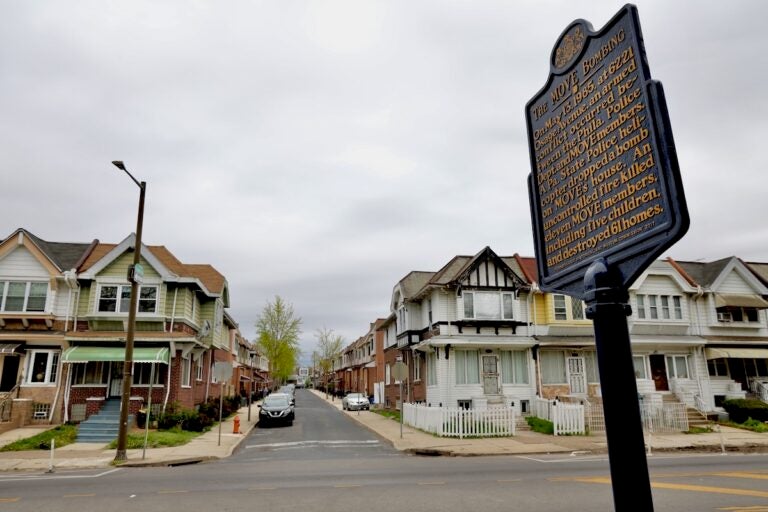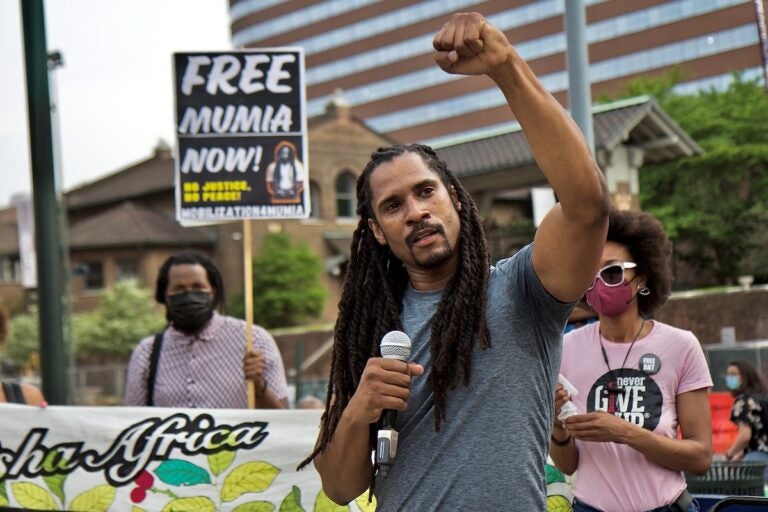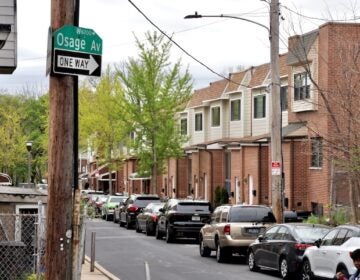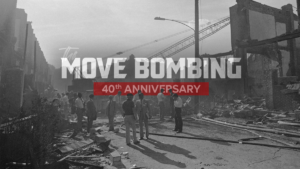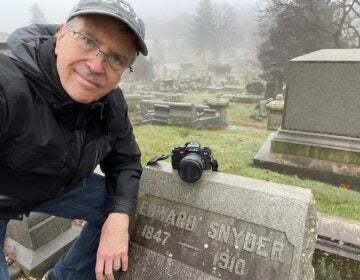MOVE at 40: Looking back at the 1985 commission and its ‘unconscionable’ findings
After five weeks of hearings with more than 90 witnesses, the MOVE Commission determined the city’s bombing was an “unconscionable” act.
Listen 7:32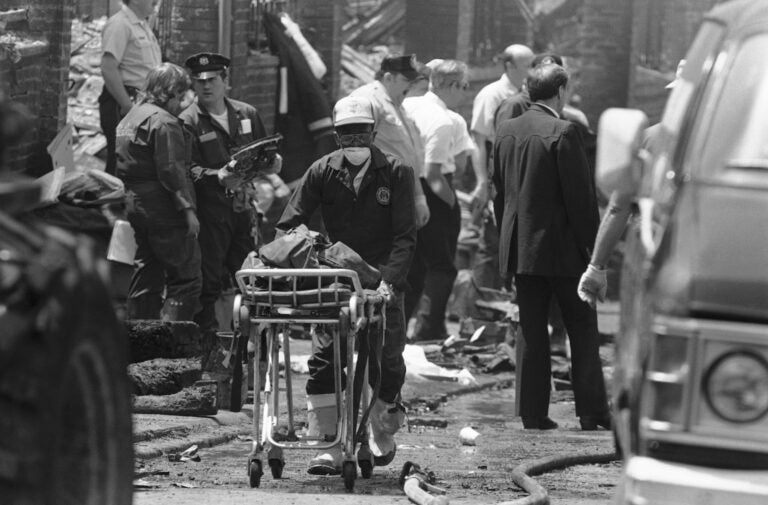
A worker transports the remains of a body found within the debris of the house of the MOVE compound in West Philadelphia, May 15, 1985. (AP Photo/George Widman, File)
From Philly and the Pa. suburbs to South Jersey and Delaware, what would you like WHYY News to cover? Let us know!
Forty years ago, the city of Philadelphia used a helicopter to drop a bomb the size of a backpack on a group of residents.
The May 13, 1985 bombing was the shocking end to a contentious standoff between police and MOVE, a group that emerged in the ‘70s as a back to nature movement, but transformed into a Black liberation group that later sparked controversy and tension with law enforcement.
In the end, 11 people were dead and 61 families were displaced as dozens of rowhouses burned in a massive fire.
Over the past several weeks, WHYY News has pored over more than 90 hours of recordings from WHYY-TV’s coverage of the inquiry that followed the bombing. The Philadelphia Special Investigation Commission, more commonly known as the MOVE Commission, officially held its hearings at WHYY.
Here’s a look back at what the MOVE Commission uncovered about the days and weeks that led up to that fateful day. The day Philadelphia earned a new nickname as the city that bombed itself.
The search for answers
“It was one of the most devastating days in the modern history of the city,” said MOVE Commission chairman William Brown. “Nearly two square blocks of a comfortable residential area lay wasted by fire. Sixty-one families, some 250 men, women and children were homeless. Their achievements and aspirations consumed in the terrible fire that we all watched on our TV sets.”
Brown led the group that spent months interviewing key participants to determine what factors led to the bombing. Brown made it clear that the group’s task was to just review the incident, not act as an investigating grand jury with the potential to issue criminal charges.
“These hearings are a major phase in the search for answers. What we hope to accomplish is to begin healing the wounds caused by the failure to resolve conflicting lifestyles in a peaceful way,” he said. “We are a true citizens’ commission, neither police nor prosecution. We are not accusatory. Instead, we are investigatory. We find the facts and report them to you, the people.”
Frustrated neighbors
The group heard from neighbors who lived near the MOVE compound at 6221 Osage Ave. The home had its windows boarded up and speakers were attached to the outside of the home that blared day and night with members of the group often screaming profanities.
Neighbors like Cassandra Carter told the commission they were fed up. Carter, who lived at 6233 Osage for three years, said MOVE members slept on the roof of the home and ran across their neighbors’ rooftops virtually every night.
“It would be like they knew when your lights went out and gave you 15 minutes. And within 15 minutes after your lights went out, you could guarantee that you would hear this ‘thud, thud thud,’ just like you would run on the parkway … you could feel the weight and the dogs,” Carter said. “They used our roofs as their playing ground.”
Another neighbor, Betty Mapp said MOVE used the outdoor speakers to wake up the community with their messages – even on Christmas Day.
“I think through the two years and a half, they knew that we had had it,” she said.
Carter and Mapp explained how the group would use young children as a shield right up until the day before the final confrontation when they felt threatened by authorities.
“On the front step of the MOVE house, three or four of the kids were sitting on a landing. A couple of them was placed on the back fence in back of the MOVE house. Sunday morning, they were still there,” Mapp said.
“Whenever they wanted to do something, they would make sure that the children were visible,” Carter said. “Those children were almost as dangerous to some people as the adults were because they were being trained in the same tactics as the adults were. They would put the kids out as visible points and they stand behind them, and you know say whatever they had to say using a child as a shield.”
The bunker and other city violations
Former City Councilman and U.S. Congressman Lucien Blackwell represented the area in 1985. He said it was time to break up the MOVE encampment for many reasons, one of which was the construction of what he called a “bunker” on the MOVE roof.
“No one’s allowed to build a bunker. Any addition that you built to your home, you have to get a permit. It’s my understanding they never received a permit,” Blackwell said.
He said the home had other violations, including fencing off the backyard, keeping dozens of dogs in the yard and running a loudspeaker 24 hours a day.
“That, in my estimation, was a violation of the civil rights of the people who lived in that area. So I once again disagree with those people who say that there were no violations,” Blackwell said.
The city had multiple reasons to act, according to Managing Director Leo Brooks. He told the commission that neighbors were upset by the things they would hear through the loudspeakers.
“The plethora of testimony and rumors and what not from people that the MOVE individuals had been broadcasting over the loudspeaker that uh ‘We’re going to tear up the neighborhood’ and ‘We’ll burn it down’ and all sorts of things of that nature,” Brooks said.
Brooks also said city officials were never sure about exactly how strong the bunker on the home’s roof was built and that uncertainty was a major concern. The bunker also worried police because it gave the group a tactical advantage.
“The bunker had around its outside plywood, which was very deceiving. It looked like some plywood shacks up there, when underneath of that plywood was, in fact, reinforcing timbers.”
Justifying the use of force
Former Pennsylvania Governor and Philadelphia Mayor Ed Rendell was District Attorney at the time of the 1985 MOVE confrontation. He was questioned by commission member Audrey Bronson about whether he considered MOVE to be a terrorist group.
“Absolutely,” Rendell replied. “They had demonstrated a past history of violence, they had demonstrated a willingness to use violent force, or the threat of violence or force to achieve their objectives.”
Rendell pointed to the first standoff with MOVE members in 1978 at their Powelton Village home, which resulted in the death of Philadelphia Police officer James Ramp. MOVE members have said they believe Ramp was killed by friendly fire
“There’s no question, people who have killed one person, injured several others, people who threatened to blow up people’s houses, people who threaten to shoot and kill neighbors, police, elected officials, I think that’s a pretty adequate description of the word terrorist. ”
The 1985 MOVE stand-off with police started on Mother’s Day May 12th when nearby neighbors were evacuated before police tried to arrest MOVE members at 6221 Osage. As District Attorney at the time, Rendell said he didn’t advise the city on what level of force was appropriate to make those arrests, but added that when the first shot was fired by people inside the home, the rules changed.
“Whatever force was justified when they went out with the warrants, that all changed instantaneously in the eyes of the law when the MOVE members opened up with fire,” he said. “Once the MOVE members started firing, their status changed radically in the eyes of the law. They at that point became forcible felons.”
Rendell said once MOVE members started shooting, that gave authorities the ability to defend against injury.
“And there’s a whole different set of laws as to the apprehension and the amount of force that can be used in the apprehension of and the prevention of the escape of forcible felons.”
Mayor Goode: ‘I made mistakes’
Once the standoff started, police fired 10,000 rounds of ammunition into or over the building, according to accounts given during the hearings.
Ultimately, the decision on how to end the stand-off rested with then-Mayor Wilson Goode.
“I made mistakes in this process,” Goode admitted to the commission.
He said he relied on his experts to come up with a plan that he approved. In hindsight, the mayor expressed doubts that the city was actually prepared for what they did.
“My reliance was on what I knew at that time. If you’re asking me now whether or not they were experts in carrying out the kind of mission that was there, I would have some questions about that at this point in time,” he told the commission.
The mayor was given a summary of the plan to attack MOVE with a bomb from the air and then decided to rely on the experts to get the job done.
“The police commissioner came in. He was confident. He gave me assurance that everything was under control. And I don’t know what else I can do as a mayor other than to rely upon those people I appoint in jobs to make those decisions. There’s a difference in my view between being hands-on and meddling.”
Goode said he received a “sufficient amount of information to be assured that there was a workable and sound plan, and there was no need for me to become further involved in those details.”
Goode told the commission he never went to the scene because he was afraid of being shot if he went out to Osage Ave.
“There was sufficient concern on my part … that I decided not to go to the scene,” Goode said.
“What he did was politically expedient rather than godfully obedient,” LaVerne Sims said of Goode. “It was not God he was obeying, but his constituents and he was wrong.”
Sims, the sister of MOVE Founder John Africa, said MOVE members were not who people thought they were.
“MOVE did not adhere to society standards, they were condemned before the world. But MOVE members are not radicals, MOVE members are not terrorists, nor criminals. They are life-filling people who have a God-given right to adhere to and practice their religion, the law of God rather than man,” she said.
Planning the confrontation
Once the city decided to confront members of MOVE in their home, police started evacuating neighbors on Mother’s Day weekend. Homes around the MOVE compound were emptied out in an abundance of caution.
Police Commissioner Greg Sambor said from the beginning of the planning they did not want to hurt anyone.
“I think everyone went out there to avoid death and injury of either side, the city side and MOVE and the kids,” Sambor said. “I was praying that the kids and all of them would exit that house at some point. They did not and I’ll have to live with that.”
After the first confrontation with MOVE in 1978 ended in violence, police were even more cautious in the lead up to the 1985 conflict.
“We were asked to devise a plan and would result in the arrest of MOVE members for whom there were outstanding warrants,” said Sgt. Albert Revel who was among those who were part of devising a plan for the 1985 action. “It was to be done under circumstances never before encountered by the Philadelphia Police Department.”
Revel said there was quite a contrast between the two confrontations.
“Unlike the confrontation with MOVE in 1978 at their home in Powelton Village, this home on Osage Avenue was in its structure so entirely unique that many new problems had to be addressed and many new options had to be explored and considered. The major concern was getting all the residents of the MOVE house out alive.”
His voice broke as he recalled for the commission a conversation he had with a young boy while he was in the neighborhood doing pre-planning work for the encounter.
“On one of my visits to the area during this planning stage, I was standing in the alleyway on Osage and a little boy came up to me and he tugged on my jacket sleeve and he said, ‘Mr.
policeman, are you going to help us?’ I looked down at him and back up at that house and I said, ‘Son, I’m going to try.’ Well, I did try.”
Revel said many people worked hard to have a successful conclusion, but the results were not what anyone expected.
“The neighbors tried, the clergy tried, the police and fire departments tried, and the city tried. As I walked away from that scene, after being on duty for 26 hours, I could feel the heat of that fire on my back and deep in my heart, I know we had failed.”
‘Reckless, ill-conceived and hastily approved’
Mayor Goode admitted during his testimony, he didn’t know every element of the tactical plan and he entrusted the people he hired to do their jobs in this situation.
“Yes, I was aware that essentially I had given to the police commissioner and to the manager director, the authority to implement an overall plan. That overall plan was to safely evacuate the house to protect the lives of police officers and firefighters, to protect civilians in the area by evacuating them and that their job was to implement the plan,” Goode said.
“It is my view that they made every attempt to carry out that plan, that the tactics which they used – though not all approved by me — I’m convinced we’re geared to carry out that plan. And therefore, I need not be personally aware of every single tactic they would use in order to achieve that plan in order to be supportive of it overall.”
Commission Member Charise Lilly said she believed there was racism in the decision.
“What we are really talking about here is institutional racism. And institutional racism … really goes beyond the fact of whether or not you have a Black mayor or a Black managing director. What we are talking about is those kind of unseen factors that will affect decisions of government,” she said. “People in decision-making positions have to be conscious and aware of that.”
Mayor Goode and Managing Director Brooks were both Black. Police Commissioner Sambor and Fire Commissioner Richmond were white.
Mayor Goode said during the commission hearing that even with the outcome of the standoff he wouldn’t have changed his mind about ending the encampment.
“The people of this city elected me to make decisions, tough ones, easy ones. It’s my job to protect them, protect life and preserve property. And I made a decision and throughout the day on May 13th, I made a series of decisions,” he said. “I’m not sure how you define the word blame. There’s not a man up here who’s not going, to the rest of his life, live with this throughout. There’s no one who’s not going to ever not wonder whether or not something different could have been done. I’m not sure what it is that you want in the end as a result of this. Lives were lost, people lost their homes, the city lost part of its public image.”
After five weeks of hearings, the commission heard from more than 90 witnesses. Members of the police bomb squad did not testify, and neither did the only member of MOVE to survive the bombing, Ramona Africa.
The commission’s final report was issued in March 1986. It offered nearly 40 recommendations on how the city could improve planning and operations in the future.
It also determined that “dropping a bomb on an occupied row house was unconscionable” and that “the plan to drop the bomb was reckless, ill-conceived, and hastily approved.”
Their report also said Sambor and Brooks were “grossly negligent” for not calling off the siege. Goode was also called “grossly negligent” as he “clearly risked the lives” of the kids who were killed in the house in an “unjustified homicide.”
Goode won re-election in 1988.

Get daily updates from WHYY News!
WHYY is your source for fact-based, in-depth journalism and information. As a nonprofit organization, we rely on financial support from readers like you. Please give today.



